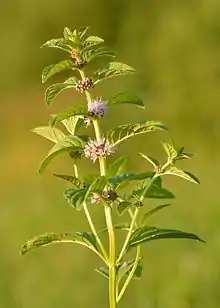Mentha arvensis
Mentha arvensis, the corn mint, field mint, or wild mint, is a species of flowering plant in the mint family Lamiaceae. It has a circumboreal distribution, being native to the temperate regions of Europe and western and central Asia, east to the Himalaya and eastern Siberia, and North America.[2][3][4] Mentha canadensis, the related species, is also included in Mentha arvensis by some authors as two varieties, M. arvensis var. glabrata Fernald (North American plants such as American Wild Mint) and M. arvensis var. piperascens Malinv. ex L. H. Bailey (eastern Asian plants such as Japanese mint).[5][6]
| Mentha arvensis | |
|---|---|
 | |
| Scientific classification | |
| Kingdom: | Plantae |
| Clade: | Tracheophytes |
| Clade: | Angiosperms |
| Clade: | Eudicots |
| Clade: | Asterids |
| Order: | Lamiales |
| Family: | Lamiaceae |
| Genus: | Mentha |
| Species: | M. arvensis |
| Binomial name | |
| Mentha arvensis | |
| Synonyms[1] | |
|
List
| |
Description
Wild mint is a herbaceous perennial plant generally growing to 10–60 cm (3.9–23.6 in) and rarely up to 100 cm (39 in) tall. It has a creeping rootstock from which grow erect or semi-sprawling squarish stems. The leaves are in opposite pairs, simple, 2–6.5 cm (0.79–2.56 in) long and 1–2 cm (0.39–0.79 in) broad, hairy, and with a coarsely serrated margin. The flowers are pale purple (occasionally white or pink), in whorls on the stem at the bases of the leaves. Each flower is 3 to 4 mm (0.12 to 0.16 in) long and has a five-lobed hairy calyx, a four-lobed corolla with the uppermost lobe larger than the others and four stamens. The fruit is a two-chambered carpel.[4][7][8][9]
Subspecies
Subspecies include:[2]
- Mentha arvensis subsp. arvensis.
- Mentha arvensis subsp. agrestis (Sole) Briq.
- Mentha arvensis subsp. austriaca (Jacq.) Briq.
- Mentha arvensis subsp. lapponica (Wahlenb.) Neuman
- Mentha arvensis subsp. palustris (Moench) Neumann
- Mentha arvensis subsp. parietariifolia (Becker) Briq.
- Mentha arvensis subsp. haplocalyx (Linnaeus, e.g. var. sachalinensis)[10]
The related species Mentha canadensis is also included in M. arvensis by some authors as two varieties, M. arvensis var. glabrata Fernald (in reference to North American plants) and M. arvensis var. piperascens Malinv. ex L. H. Bailey (in reference to eastern Asian plants).[5][11]
Uses
The leaves have been made into tea to treat colds or aid digestion.[12]
Chemical substances that can be extracted from wild mint include menthol, menthone, isomenthone, neomenthol, limonene, methyl acetate, piperitone, beta-caryophyllene, alpha-pinene, beta-pinene, tannins and flavonoids.[13] Mint extracts and menthol-related chemicals are used in food, drinks, cough medicines, creams and cigarettes.[13] Menthol is widely used in dental care, as a mouthwash potentially inhibiting streptococci and lactobacilli bacteria.[14]
Diseases
Two main diseases that can significantly damage Japanese mint (M. arvensis var. piperascens) and its yield are the rust fungus and the mildew attacks.[15] Mildew attacks usually only occur on the west coast of United States where the weather can be foggy and humid, a condition that attracts mildew. Rust fungus is a disease that is common for most of the Mentha plants such as peppermint and spearmint. These diseases are flagged due to the almost to none probability of controlling once it starts in a mint farm. They are typically cut immediately when discovered to help reduce the probability of contaminating the rest of the plant leaves.[15]
References
- "Mentha arvensis L." Plants of the World Online. Board of Trustees of the Royal Botanic Gardens, Kew. 2017. Retrieved 1 August 2020.
- Euro+Med Plantbase Project: Mentha arvensis Archived 2011-07-18 at the Wayback Machine
- "Mentha arvensis". Germplasm Resources Information Network (GRIN). Agricultural Research Service (ARS), United States Department of Agriculture (USDA). Retrieved 18 December 2017.
- "Mentha arvensis L." Flora of NW Europe. 2008-03-11. Archived from the original on 2008-03-11.
- "Mentha canadensis". Germplasm Resources Information Network (GRIN). Agricultural Research Service (ARS), United States Department of Agriculture (USDA). Retrieved 18 December 2017.
- Quattrocchi, Umberto (1947), CRC World dictionary of plant names: Common names, Scientific Names, Eponyms, Synyonyms, and Etymology, III M-Q, CRC Press, p. 1659
- Blamey, M. & Grey-Wilson, C. (1989). Flora of Britain and Northern Europe. ISBN 0-340-40170-2
- Huxley, A., ed. (1992). New RHS Dictionary of Gardening. Macmillan ISBN 0-333-47494-5.
- "Corn mint: Mentha arvensis". NatureGate. Retrieved 2013-12-12.
- "Mentha sachalinensis in Flora of China". Flora of China (series) Vol 17. p. 237.
Mentha sachalinensis (Briquet ex Miyabe & Miyake) Kudô, J. Coll. Sci. Imp. Univ. Tokyo. 43(10): 47. 1921. 东北薄荷 dong bei bo he.
- Quattrocchi, Umberto (1947). CRC World dictionary of plant names: Common names, Scientific Names, Eponyms, Synyonyms, and Etymology. III M-Q. CRC Press. p. 1659.
- Fagan, Damian (2019). Wildflowers of Oregon: A Field Guide to Over 400 Wildflowers, Trees, and Shrubs of the Coast, Cascades, and High Desert. Guilford, CT: FalconGuides. p. 53. ISBN 978-1-4930-3633-2. OCLC 1073035766.
- Maria Kostka-Rokosz, Yelena Yalli, Lana Dvorkin, Julia Whelan. "Mentha Arvensis Piperascens". Boston Healing Landscape Project. Boston University School of Medicine. Archived from the original on 2015-03-19. Retrieved 2013-12-12.CS1 maint: uses authors parameter (link)
- Freires IA, Denny C, Benso B, de Alencar SM, Rosalen PL (22 April 2015). "Antibacterial Activity of Essential Oils and Their Isolated Constituents against Cariogenic Bacteria: A Systematic Review". Molecules. 20 (4): 7329–7358. doi:10.3390/molecules20047329. PMC 6272492. PMID 25911964.CS1 maint: uses authors parameter (link)
- Sievers, A. F., & Lowman, M. S. (1933). Commercial possibilities of Japanese mint in the United States as a source of natural menthol (No. 378). US Dept. of Agriculture.
External links
 Media related to Mentha arvensis at Wikimedia Commons
Media related to Mentha arvensis at Wikimedia Commons Data related to Mentha arvensis at Wikispecies
Data related to Mentha arvensis at Wikispecies- Jepson Manual Treatment
- Photo gallery